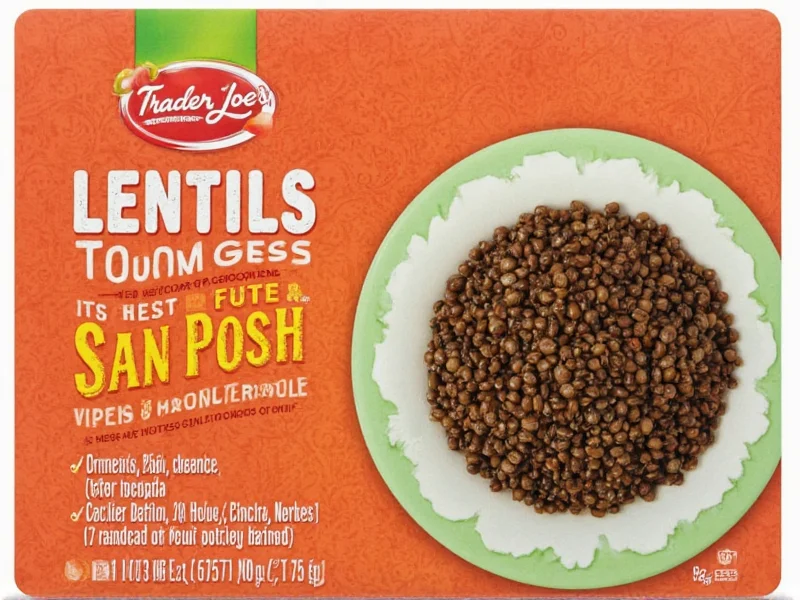When shopping for pantry staples, Trader Joe's lentils consistently rank among the most reliable and affordable options available. The popular grocery chain provides accessible plant-based protein that meets diverse cooking needs without compromising on quality. Understanding their specific lentil offerings helps shoppers make informed decisions based on recipe requirements, nutritional goals, and budget considerations.
Trader Joe's Lentil Varieties Explained
Trader Joe's maintains a consistent selection of lentil types that cater to different culinary applications. Their French green lentils (marketed as 'French Lentils') feature a peppery flavor and firm texture that holds shape during cooking—ideal for cold salads, grain bowls, and side dishes. These typically cook in 20-25 minutes without pre-soaking.
Their red lentils, labeled simply as 'Red Lentils', have a milder, slightly sweet flavor and break down more readily when cooked. This characteristic makes them perfect for soups, stews, and Indian dals where a creamy texture is desired. Red lentils usually require 15-20 minutes of simmering.
Occasionally, Trader Joe's stocks specialty varieties like black beluga lentils, which resemble caviar when cooked and offer an earthy flavor profile. These limited-edition offerings appear seasonally, particularly around holiday cooking months.
| Lentil Type | Cooking Time | Best Uses | Price (16oz) |
|---|---|---|---|
| French Green | 20-25 minutes | Salads, side dishes, grain bowls | $3.49 |
| Red Lentils | 15-20 minutes | Soups, stews, dals, purees | $2.99 |
| Black Beluga (seasonal) | 25-30 minutes | Festive salads, special occasion dishes | $3.99 |
Nutritional Benefits of Trader Joe's Lentils
All Trader Joe's lentil varieties deliver impressive nutritional profiles. A standard 1/4 cup serving of dry lentils provides approximately 13g of plant-based protein and 10g of dietary fiber. These legumes contain significant amounts of iron, folate, and manganese while remaining naturally fat-free and low in sodium.
When comparing Trader Joe's lentils nutrition facts to national brands, their products typically match or exceed competitors in protein content per serving while maintaining comparable fiber levels. The absence of added preservatives or seasonings in their plain lentil offerings gives home cooks complete control over flavor profiles.
Comparing Trader Joe's Lentils to Other Retailers
Price comparisons reveal Trader Joe's lentils cost approximately 20-30% less than equivalent organic options at conventional grocery chains. When evaluating Trader Joe's lentils vs. Whole Foods' 365 brand, the quality remains comparable while offering significant savings. Their lentils also frequently outperform store brands at major supermarkets in blind taste tests conducted by independent food reviewers.
Unlike some budget grocery chains that offer only split or heavily processed lentils, Trader Joe's maintains whole lentil varieties that retain superior texture during cooking. This commitment to quality ingredients explains their popularity among both novice cooks and professional chefs seeking reliable pantry staples.
Cooking Techniques for Perfect Results
Mastering how to cook Trader Joe's French green lentils ensures optimal texture for salads and side dishes. Rinse 1 cup lentils thoroughly, then combine with 2.5 cups water or broth in a saucepan. Bring to a boil, reduce heat, and simmer uncovered for 20-25 minutes until tender but still holding shape. Drain any excess liquid before using.
For red lentils, use a 1:1.5 ratio of lentils to liquid as they absorb more moisture. These cook faster—typically 15-20 minutes—and naturally break down to create creamy textures ideal for soups and purees. Adding acidic ingredients like tomatoes too early can prevent proper softening, so wait until lentils are nearly tender before incorporating these elements.
Customer Experiences and Popular Recipes
Analysis of customer feedback shows Trader Joe's lentils receive consistent praise for consistent quality across batches. Frequent shoppers particularly appreciate how their French green lentils rarely require sorting for debris compared to some conventional grocery brands.
Popular applications include:
- French lentil salad with Dijon vinaigrette and roasted vegetables
- Red lentil soup with coconut milk and curry spices
- Lentil shepherd's pie with mashed potato topping
- Simple weeknight lentil and vegetable stir-fry
Many home cooks report success using Trader Joe's lentils in Instant Pot recipes, reducing cooking time by nearly half while maintaining excellent texture. Their consistent size and quality minimize the risk of undercooked or mushy results that sometimes occur with less uniform lentil products.
Storage Recommendations and Shelf Life
Proper storage maximizes the shelf life of Trader Joe's lentils. Keep unopened bags in a cool, dark pantry for up to 12 months past the printed date. After opening, transfer lentils to an airtight container to prevent moisture absorption and potential insect infestation. Stored properly, opened lentils maintain quality for 6-8 months.
Unlike canned lentils that contain added sodium, dried lentils from Trader Joe's offer complete control over seasoning while providing superior texture in finished dishes. This pantry staple's versatility makes it worth keeping multiple varieties on hand for quick, nutritious meals.











 浙公网安备
33010002000092号
浙公网安备
33010002000092号 浙B2-20120091-4
浙B2-20120091-4